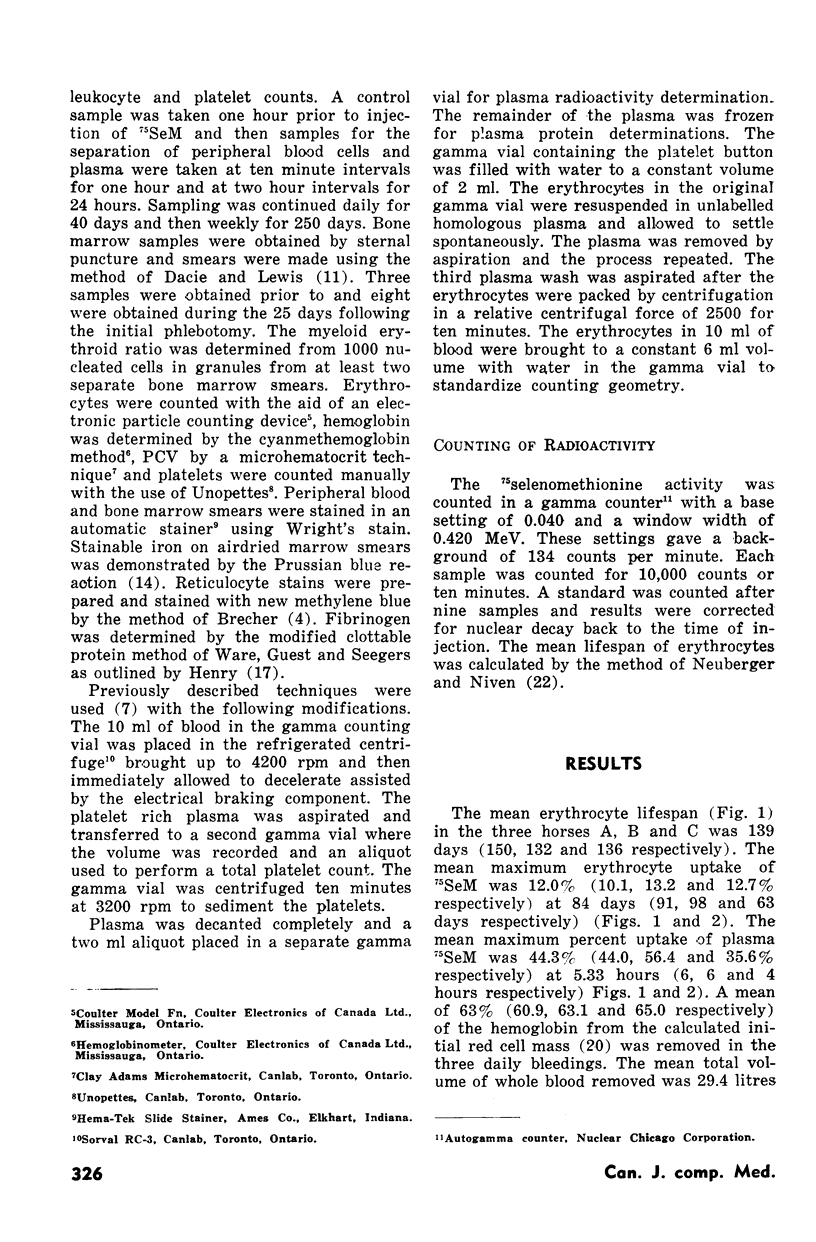Abstract
Hemorrhagic anemia was experimentally produced in three Standardbred horses by removing approximately 63% of the red cell mass and the accompanying plasma during a three day interval. Red cell parameters were examined daily for 45 days and then weekly until termination of the experiment 250 days after production of the anemia. Leukocytes, platelets and bone marrow aspirates were examined at regular intervals for 25 days after the final phlebotomy. At 24 hours after the last bleeding, 75-selenomethionine was injected intravenously to measure the lifespan of the newly produced erythrocytes. The erythrocyte lifespan was found to be 139 days as compared to the 155 day erythrocyte lifespan for three normal standardbred horses measured previously by similar techniques. The maximum decrease in erythrocyte numbers occurred four, two and two days following the last phlebotomy to 43, 39 and 44% of the original values. The prebleeding erythrocyte levels were regained at approximately 63, 91 and 98 days respectively. During the initial 45 days post phlebotomy the maximum increase in mean cell colume was 2, 4 and 7 mj-3 respectively. During the recovery period there was erythrocyte production of 6.84, 6.99, and 6.12 x 10-9 cells/kg/day. At the same time the absolute production of hemoglobin was 44.6, 50.0, and 51.0/gm/day or on a relative basis 0.096, 0.114 and 0.113 gm/kg/day.
Full text
PDF







Selected References
These references are in PubMed. This may not be the complete list of references from this article.
- Arriaga de la Cabada L., Labardini J., Sánchez-Medal L. Hemolysis and erythropoiesis. V. The utilization of hemoglobin iron by bled anemic dogs. Proc Soc Exp Biol Med. 1969 May;131(1):279–281. doi: 10.3181/00379727-131-33858. [DOI] [PubMed] [Google Scholar]
- BAINTON D. F., FINCH C. A. THE DIAGNOSIS OF IRON DEFICIENCY ANEMIA. Am J Med. 1964 Jul;37:62–70. doi: 10.1016/0002-9343(64)90212-8. [DOI] [PubMed] [Google Scholar]
- BERLIN N. I., LOTZ C. Life span of the red blood cell of the rat following acute hemorrhage. Proc Soc Exp Biol Med. 1951 Dec;78(3):788–790. doi: 10.3181/00379727-78-19220. [DOI] [PubMed] [Google Scholar]
- Bremner K. C. The reticulocyte response in calves made anaemic by phlebotomy. Aust J Exp Biol Med Sci. 1966 Jun;44(3):251–258. doi: 10.1038/icb.1966.25. [DOI] [PubMed] [Google Scholar]
- Carter E. I., Valli V. E., McSherry B. J., Milne F. J., Robinson G. A., Lumsden J. H. The kinetics of hematopoiesis in the light horse. I. The lifespan of peripheral blood cells in the normal horse. Can J Comp Med. 1974 Jul;38(3):303–313. [PMC free article] [PubMed] [Google Scholar]
- Fairbanks V. F. Diagnostic tests for iron deficiency. Ann Intern Med. 1971 Oct;75(4):640–642. doi: 10.7326/0003-4819-75-4-640. [DOI] [PubMed] [Google Scholar]
- Gōmōri G. Microtechnical Demonstration of Iron: A Criticism of its Methods. Am J Pathol. 1936 Sep;12(5):655–664.1. [PMC free article] [PubMed] [Google Scholar]
- Hamstra R. D., Block M. H. Erythropoiesis in response to blood loss in man. J Appl Physiol. 1969 Oct;27(4):503–507. doi: 10.1152/jappl.1969.27.4.503. [DOI] [PubMed] [Google Scholar]
- Ingram M., Coopersmith A. Reticulated platelets following acute blood loss. Br J Haematol. 1969 Sep;17(3):225–229. doi: 10.1111/j.1365-2141.1969.tb01366.x. [DOI] [PubMed] [Google Scholar]
- Lumsden J. H., Valli V. E., McSherry B. J., Willoughby R. A. The Piromen Test as an assay of bone marrow granulocyte reserves in the calf. I. Studies on bone marrow and peripheral blood leukocytes. Can J Comp Med. 1974 Jan;38(1):56–64. [PMC free article] [PubMed] [Google Scholar]
- MARCILESE N. A., VALSECCHI R. M., FIGUEIRAS H. D., CAMBEROS H. R., VARELA J. E. NORMAL BLOOD VOLUMES IN THE HORSE. Am J Physiol. 1964 Jul;207:223–227. doi: 10.1152/ajplegacy.1964.207.1.223. [DOI] [PubMed] [Google Scholar]
- Marcilese N. A., Figueiras H. D., Valsecchi R. M., Fraga A. H., Camberos H. R., Varela J. E. Erythrokinetics in the horse. Am J Physiol. 1965 Oct;209(4):727–730. doi: 10.1152/ajplegacy.1965.209.4.727. [DOI] [PubMed] [Google Scholar]
- NEUBERGER A., NIVEN J. S. F. Haemoglobin formation in rabbits. J Physiol. 1951 Feb;112(3-4):292–310. doi: 10.1113/jphysiol.1951.sp004530. [DOI] [PMC free article] [PubMed] [Google Scholar]
- STOHLMAN F., Jr Erythropoiesis. N Engl J Med. 1962 Aug 16;267:342–348. doi: 10.1056/NEJM196208162670707. [DOI] [PubMed] [Google Scholar]
- STOHLMAN F., Jr Humoral regulation of erythropoiesis. VII. Shortened survival of erythrocytes produced by erythropoietine or severe anemia. Proc Soc Exp Biol Med. 1961 Aug-Sep;107:884–887. doi: 10.3181/00379727-107-26784. [DOI] [PubMed] [Google Scholar]
- Spencer R. P., Evans B. J. Effects of an inconstant blood volume on apparent erythrocyte survival. Int J Appl Radiat Isot. 1968 Mar;19(3):283–286. doi: 10.1016/0020-708x(68)90025-2. [DOI] [PubMed] [Google Scholar]
- Valli V. E., McSherry B. J., Hulland T. J., Robinson G. A., Gilman J. P. The kinetics of haematopoiesis in the calf. II. An autoradiographical study of erythropoiesis in normal, anaemic and endotoxin treated calves. Res Vet Sci. 1971 Nov;12(6):551–564. [PubMed] [Google Scholar]
- Winter H. Changes of the red blood cell hemogram in posthemorrhagic anemia in sheep. Am J Vet Res. 1966 Jul;27(119):891–897. [PubMed] [Google Scholar]


